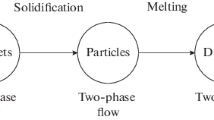Abstract
The results from an experimental study of reduced-gravity two-phase flows are reported in this paper. The experiments were conducted in simulated reduced-gravity conditions in a ground-based test facility with a circular test section of 25 mm inner diameter. The flow conditions for which data were acquired lie in the dispersed droplet to slug flow transition and slug flow regime. Local data were acquired for 17 different flow conditions at three axial locations. The acquired data complement and extend those discussed in an earlier paper by the authors (Vasavada et al. in, Exp Fluids 43: 53–75, 2007). The radial profiles and axial changes in the local data are analyzed and discussed in this paper. The area-averaged data, in conjunction with the local data, are discussed to highlight important interaction mechanisms occurring between fluid particles, i.e., drops. The data clearly show the effect of progressive coalescence leading to formation of slug drops. Furthermore, the shape of slug drops in reduced-gravity conditions was observed to be different from that in normal-gravity case. The analyses presented here show the presence of drop coalescence mechanisms that lead to the formation of slug drops and transition from dispersed droplet flow to the slug flow regime. The most likely causes of the coalescence mechanism are random collision of drops driven by turbulence eddies in the continuous phase and wake entrainment of smaller drops that follow preceding larger drops in the wake region. Data from flow conditions in which the breakup mechanism due to impact of turbulent eddies on drops illustrate the disintegration mechanism.















Similar content being viewed by others
References
Brauner N (2001) The prediction of dispersed flows boundaries in liquid-liquid and gas-liquid systems. Int J Multiphase Flow 27(5):885–910
Bugg JD, Mack K, Rezkallah KS (1998) A numerical model of Taylor bubbles rising through stagnant liquids in vertical tubes. Int J Multiphase Flow 24:271–281
Clift R, Grace J, Weber M (1978) Bubbles, drops and particles. Academic Press, London
Colin C, Fabre J, Dukler A (1991) Gas-liquid flow at microgravity conditions -I: dispersed bubble and slug flow. Int J Multiphase Flow 17:533–544
Colin C, Fabre J, Dukler A (1993) Influence of gravity on void and velocity distribution in two-phase gas-liquid flow in pipe. Adv Space Res 7:141–145
Colin C, Fabre J, Dukler A (1996) Bubble and slug flow at microgravity conditions: state of knowledge and open questions. Chem Eng Commun 141–142:155–173
Flores J, Chen X, Sarica C, Brill J (1997) Characterization of oil-water flow patterns in vertical and deviated wells. In: 1997 SPE annual technical conference and exhibition, San Antonio, TX, SPE paper 38810, pp 1–10
Fu X (2001) Interfacial area measurement and transport modeling in air-water two-phase flow. PhD thesis, Purdue University, West Lafayette, IN, USA
Govier GK, Aziz K (1972) The flow of complex mixtures in pipes. Van Nostrand Reinhold Co., New York
Iguchi M, Terauchi Y (2001) Microgravity effects on the rising velocity of bubbles and slugs in vetical pipes of good and poor wettability. Int J Multiphase Flow 27:2189–2198
Ishii M, Hibiki T (2006) Thermo-fluid dynamic theory of two-phase flow. Springer, New York
Janicot A (1988) Studies of gas-liquid flow under reduced gravity conditions. Master’s thesis, Universitiy of Houston
Kamp A, Chesters A, Colin C, Fabre J (2001) Bubble coalescence in turbulent flows: A mechanistic model for turbulence-induced coalescence applied to microgravity bubbly pipe flow. Int J Multiphase Flow 27:1363–1396
Kim S (1999) Interfacial area transport equation and measurement of local interfacial characteristics. PhD thesis, Purdue University, West Lafayette, IN, USA
Kim S, Fu X, Wang X, Ishii M (2000) Development of the miniaturized four-sensor conductivity probe and the signal processing scheme. Int J Heat Mass Transf 43:4101–4118
Mishima K, Ishii M (1984) Flow regime transition criteria for upward two-phase flow in vertical tubes. Int J Heat Mass Transf 27(5):723–737
Scheele G, Meister B (1968) Drop formation at low velocities in liquid-liquid systems. AIChe J 14:9–19
Sun X, Kim S, Ishii M, Beus S (2004) Modeling of bubble coalescence and disintegration in confined upward two-phase flow. Nucl Eng Des 230:3–26
Takamasa T, Iguchi T, Hazuku T, Hibiki T, Ishii M (2003) Interfacial area transport of bubbly flow under microgravity environment. Int J Multiphase Flow 29:291–304
Vasavada S (2008) Interfacial area transport for reduced-gravity two-phase flows. PhD thesis, Purdue University, West Lafayette, IN, USA
Vasavada S, Sun X, Ishii M, Duval W (2007) Study of two-phase flows in reduced gravity using ground based experiments. Exp Fluids 43:53–75
Wu Q, Kim S, Ishii M, Beus S (1998) One-group interfacial area transport in vertical bubbly flow. Int J Heat Mass Transf 41(8–9):1103–1112
Acknowledgments
The current research was supported by the National Aeronautics and Space Administration, the Office of Biological and Physical Research under grant NNC04GA26G administered by the NASA Glenn Research Center, Cleveland, OH. The authors would also like to acknowledge Dr. Francis Chiaramonte of NASA for his support of the research. The expertise and advice of Dr. Y. Mi of E’nurga Inc., West Lafayette, IN, on the instrumentation used is sincerely appreciated.
Author information
Authors and Affiliations
Corresponding author
Rights and permissions
About this article
Cite this article
Vasavada, S., Sun, X., Ishii, M. et al. An experimental study of two-phase flow in simulated reduced-gravity condition: dispersed droplet to slug flow transition and slug flow. Exp Fluids 50, 1373–1384 (2011). https://doi.org/10.1007/s00348-010-0976-z
Received:
Revised:
Accepted:
Published:
Issue Date:
DOI: https://doi.org/10.1007/s00348-010-0976-z




